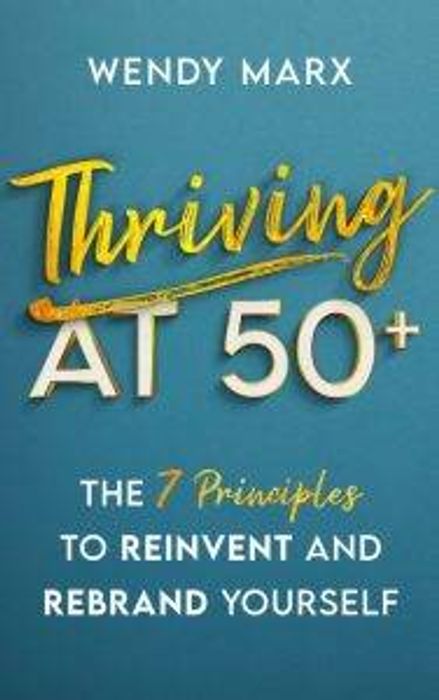To Reinvent Yourself After 50, Learn How to Tell Your Story
Advice for job hunting or switching careers, from 'Thriving at 50+'
(Wendy Marx has had five careers: social worker, newspaper reporter, marketer, PR entrepreneur and now career coach and reinvention expert. In this excerpt from her new book, Thriving at 50+, Marx explains why knowing how to tell your story can help you find work in midlife or find your next act.)

Imagine this scenario: You’re fired from a job you loved after 30 years. What do you tell yourself and others? How do you handle the pain, the upset and blow to your ego?
Herminia Ibarra and Kent Lineback, in a Harvard Business Review article, wrote that in the beginning of a transition when the future isn’t clear, you will need to “craft different stories for different possible selves (and the various audiences that relate to those selves).”
“You’ve been a banker, human resource specialist, salesperson, electrician, lawyer, whatever for a long time,” Marci Alboher, career and workplace trends expert and Encore.org vice president, wrote in her book The Encore Career. “So, expect to feel strange when you leave an identity behind and no longer have an easy way to describe yourself.”
“All good stories have a characteristic so basic and necessary it’s often assumed.”
Creating a story — or revising the one you’ve told — can help you accept your reinvention transition and see its best features. In a transition, your story is your road map. It needs to define both who you are and where you’re headed.
What Is a Story?
In their Harvard Business Review article, Ibarra and Lineback wrote about a networking event of senior managers who were downsized from lucrative jobs. Unfortunately, most of the managers, in sharing what they had done, simply recounted a laundry list of credentials and jobs. As a result, the audience didn’t care, because they weren’t clear on how to help.
The senior managers failed to distinguish between facts and a story.
“All good stories have a characteristic so basic and necessary it’s often assumed,” said Ibarra and Lineback. “That quality is coherence, and it’s crucial to life stories of transition.”
If a story is meaningful, the past is related to the present and the present provides a window to the future.
Connecting Your Dots
But some people don’t connect the dots between their past, present and future. They will say: “I used to do this, and now I do that.”
Instead, they could explain how their skills will transfer, so they’ll be able to add value in the new job.
After losing her marketing job, a woman I know named Grace took some time off for self-analysis. That paid off in an aha moment. Coaching, mentoring and teaching had always been a part of her career and were things she enjoyed. But they were minor notes, not the dominant soundtrack of her career.
She asked herself: “‘Why don’t I figure out how to make that a more major part of my job?’ Learning. Adult education. I had been toying with that in my mind in prior years, but now the pieces fit. The story fit. And I was like, ‘Wow.’ I felt good about it. This does make sense. The pieces do hang together.”
Having her bearings, she could then ask herself what classes or certificates to take to compensate for any knowledge gaps and which people to talk with to pinpoint opportunities. Suddenly, what had seemed to be a closed world opened up.
"If you can’t tell your own story, how can I believe you would be good at telling my story and my company’s story?”
Grace’s story has evolved. Where originally she had offered up a buffet of her skills and asked for feedback from people she networked with, she now talks about how her social science background, her understanding of people, her communications skills and her joy in turning “lightbulbs on in people” make her a good business educator.

While Grace’s story was becoming clearer, it wasn’t yet complete. She wanted to flesh it out so people would understand her desire to head in a new direction.
So, she revisited her resumé, thinking about how she could enhance her story. “Instead of just looking for work, why don’t I just do some work?” she told herself. Grace volunteered as the director of educational development for a nonprofit, advocating for women 50+ in the workplace. “It’s a project that I could put in my portfolio and say, ‘I did this from soup to nuts. I made this plan. I created these educational opportunities.’”
Practice Makes Perfect
Like any performance, a story gets better in the retelling. Don’t expect to have a great story off the bat. Wrote Ibarra and Lineback: “Tell and retell your story; rework it like a draft of an epic novel until the right version emerges.”
“I tell people to practice their story in phone calls,” said Sree Sreenivasan, Marshall R. Loeb visiting professor of digital innovation at Stony Brook University School of Journalism and a social media guru. “Why should people listen to you? If you can’t tell your own story, how can I believe you would be good at telling my story and my company’s story?”
A career story’s power is reinforced with examples and proof points. Grace planned to create a resource kit to showcase her volunteer work. She recognized that she had to sing her own song louder.
Don’t be afraid to tell your own story assertively and with gusto. Otherwise, you risk others misinterpreting, and even misunderstanding, your story.
Storytelling Cheat Sheet
Here are the five keys to good storytelling:
- Initially, when what you want to do is not clear, craft different stories for different audiences.
- Connect the dots linking your past to your future aspirations.
- Create a story that’s logical yet engaging. Show some passion.
- Enhance your story through volunteering and creating a resource kit.
- Practice. Practice. Practice your story.

